Advantages and Disadvantages of Laser Doppler Anemometry (LDA)
Advertisement
Let’s explore the pros and cons of using Laser Doppler Anemometry (LDA), a technique that uses lasers to measure fluid flow velocity.
Introduction to LDA
LDA works by focusing a laser beam at a specific point where we want to measure velocity. Tiny tracer particles, which are naturally present or introduced into the fluid, scatter the light. A photodetector then picks up this scattered light. The key here is that the velocity of these tracer particles is assumed to be the same as the fluid’s velocity. This movement causes a Doppler shift in the frequency of the scattered light, and this shift is directly related to the fluid’s velocity.
The velocity of the flow can be calculated using the following formula:
f = (2 _ V _ sin(θ/2)) / λ
Where:
- λ = Wavelength of the laser beam in the fluid
- V = Velocity of fluid flow

Image: LDA-Laser Doppler Anemometer
Advantages of LDA
Here are some key benefits of using LDA:
- High Frequency Response: LDA boasts a very high frequency response, typically in the MHz range. This means it can accurately capture rapid changes in flow velocity.
- Versatile Application: It can be used to measure the flow of both liquids and gases, making it a flexible tool in many situations.
- Biomedical Applications: LDA is also valuable in the biomedical field, especially for measuring blood flow.
Disadvantages of LDA
Like any technology, LDA has its limitations:
- Tracer Particles Required: LDA can’t be used for measuring clean flows directly. It requires the presence of tracer particles, which sometimes need to be added.
- Velocity Discrepancies: If the velocity of the light-scattering particles isn’t the same as the actual fluid velocity, it can introduce errors in the measurement. This is an important factor to keep in mind when using LDA.
Advertisement
 T&M
T&M 








